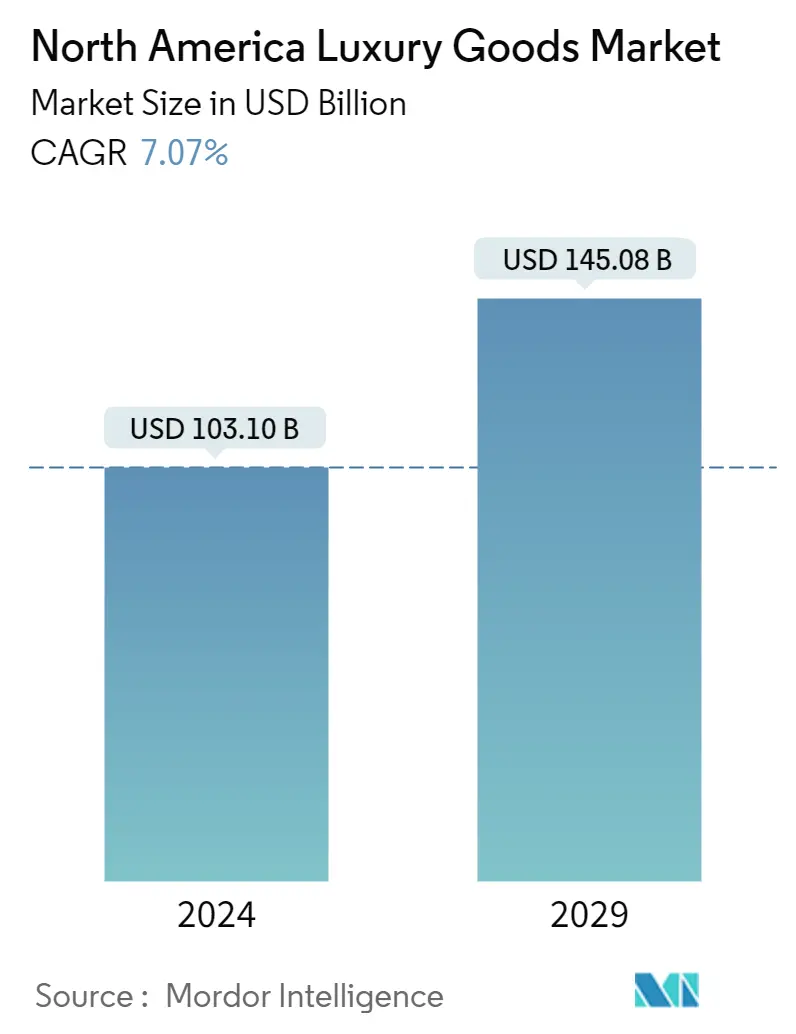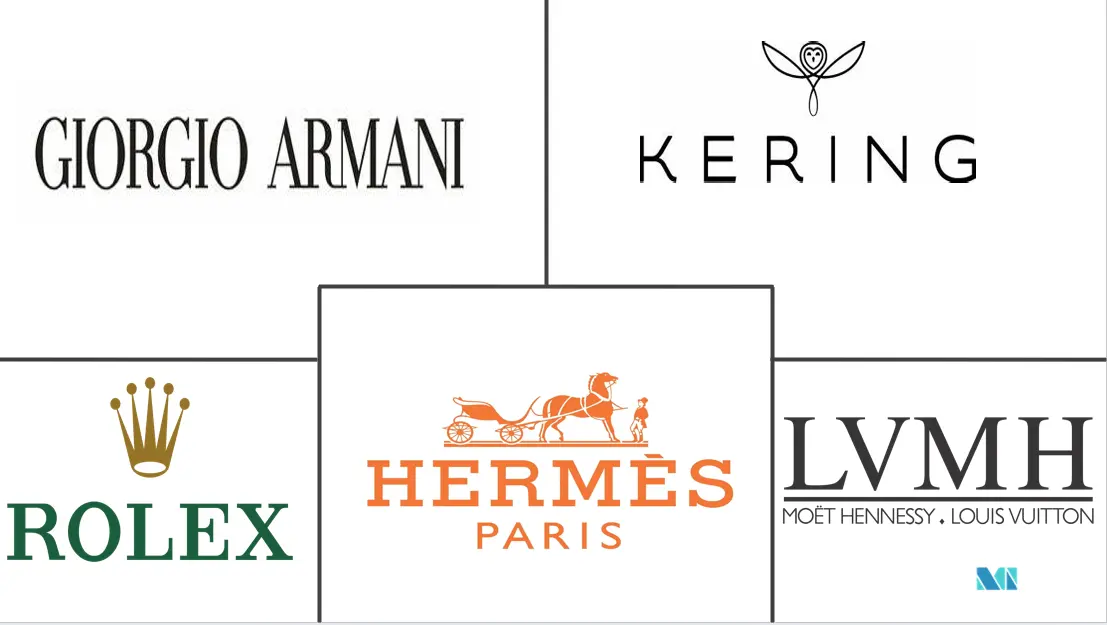Market Size of North America Luxury Goods Industry

| Study Period | 2018 - 2029 |
| Base Year For Estimation | 2023 |
| Market Size (2024) | USD 103.10 Billion |
| Market Size (2029) | USD 145.08 Billion |
| CAGR (2024 - 2029) | 7.07 % |
| Market Concentration | Low |
Major Players
*Disclaimer: Major Players sorted in no particular order |
North America Luxury Goods Market Analysis
The North America Luxury Goods Market size is estimated at USD 103.10 billion in 2024, and is expected to reach USD 145.08 billion by 2029, growing at a CAGR of 7.07% during the forecast period (2024-2029).
North America demonstrates a more extensive base of fashion-conscious consumers with comparatively higher spending power, keeping up with the latest market trends for personal accessories like clothing, purses, watches, and jewelry. Social media influencers that promote luxury businesses' newly released collections to draw in customers impact consumer behavior. Customers are also drawn to luxury goods because of their distinctive designs, longevity, comfort, and aesthetics, which set them apart from fast fashion accessories. Furt more, the region has a strong network of single-brand and multi-brand stores in airports and shopping centers, enabling affluent customers to select from various product choices from regional and international luxury brands.
The region's demand for luxury products is significantly high, owing to the high disposable incomes. Moreover, North America remains one of the most important destinations for luxury tourism, making it unique as a market for luxury retail in the region. The e emergence of e-commerce has provided easy access to product-related information and prices through online sources at any time. This significant trend has further contributed to the overall growth of the North American luxury market.
After facing a slowdown during Covid 19, the North American luxury goods market has undergone a V-shape rebound. Additionally, demand for luxury goods is constantly rising owing to the increasing number of high-income individuals and the introduction of new innovative luxury goods in the region. In addition to traditional luxury products, digital assets and the virtual world, which include social media, gaming, and the metaverse, are becoming increasingly important in terms of luxury brands' value propositions, which will become increasingly important in the forecasted period. To compete in the increasingly competitive luxury market, luxury brands have the opportunity to be critical players in the development of virtual worlds.
North America Luxury Goods Industry Segmentation
Luxury goods, also called superior goods, are products with a demand directly related to consumer income exponentially. The luxury goods market in North America is segmented based on type, distribution channels, and geography The market is segmented by clothing and apparel, footwear, bags, jewelry, watches, and other types. Based on the distribution channel, the market is segmented into single-branded stores, departmental stores, online stores, and other distribution channels. Also, the study analyzes the luxury goods market in emerging and established markets across North America, including the United States, Canada, Mexico, and the Rest of North America. For each segment, the market sizing and forecasts have been done based on value (in USD million).
| By Type | |
| Clothing and Apparel | |
| Footwear | |
| Bags | |
| Jewelry | |
| Watches | |
| Other Types |
| By Distribution Channel | |
| Single-branded Stores | |
| Multi-brand Stores | |
| Online Stores | |
| Other Distribution Channels |
| By Country | |
| United States | |
| Canada | |
| Mexico | |
| Rest of North America |
North America Luxury Goods Market Size Summary
The North American luxury goods market is poised for significant growth, driven by a robust consumer base with high spending power and a keen interest in fashion. The region's market is characterized by a strong presence of both single-brand and multi-brand stores, particularly in affluent areas and shopping hubs, which cater to the diverse preferences of luxury consumers. The influence of social media and digital platforms has further shaped consumer behavior, making luxury goods more accessible and appealing due to their unique designs and quality. The market's expansion is also supported by the region's status as a key destination for luxury tourism, which attracts affluent shoppers from around the world. The rise of e-commerce has enhanced consumer access to luxury products, contributing to the market's resilience and growth trajectory.
The luxury goods sector in North America has rebounded strongly post-COVID-19, with increasing demand fueled by a growing number of high-income individuals and innovative luxury offerings. The market is becoming increasingly competitive, with major players like Kering, Gucci, and Louis Vuitton expanding their presence through new store openings and strategic acquisitions. The focus on digital assets and virtual experiences, such as the metaverse, is reshaping luxury brands' value propositions, offering new avenues for engagement and sales. The market's growth is further bolstered by an expanding young working-class population and rising consumer awareness of high-quality goods. As luxury brands continue to innovate and expand, the North American market is expected to maintain its upward momentum, driven by both traditional and digital retail channels.
North America Luxury Goods Market Size - Table of Contents
-
1. MARKET DYNAMICS
-
1.1 Market Drivers
-
1.2 Market Restraints
-
1.3 Porter's Five Forces Analysis
-
1.3.1 Threat of New Entrants
-
1.3.2 Bargaining Power of Buyers/Consumers
-
1.3.3 Bargaining Power of Suppliers
-
1.3.4 Threat of Substitute Products
-
1.3.5 Intensity of Competitive Rivalry
-
-
-
2. MARKET SEGMENTATION
-
2.1 By Type
-
2.1.1 Clothing and Apparel
-
2.1.2 Footwear
-
2.1.3 Bags
-
2.1.4 Jewelry
-
2.1.5 Watches
-
2.1.6 Other Types
-
-
2.2 By Distribution Channel
-
2.2.1 Single-branded Stores
-
2.2.2 Multi-brand Stores
-
2.2.3 Online Stores
-
2.2.4 Other Distribution Channels
-
-
2.3 By Country
-
2.3.1 United States
-
2.3.2 Canada
-
2.3.3 Mexico
-
2.3.4 Rest of North America
-
-
North America Luxury Goods Market Size FAQs
How big is the North America Luxury Goods Market?
The North America Luxury Goods Market size is expected to reach USD 103.10 billion in 2024 and grow at a CAGR of 7.07% to reach USD 145.08 billion by 2029.
What is the current North America Luxury Goods Market size?
In 2024, the North America Luxury Goods Market size is expected to reach USD 103.10 billion.

